 Back to selection
Back to selection
Shutter Angles
Conversations with DPs, directors and below-the-line crew by Matt Mulcahey
“We Don’t Find Shots, We Build Them”: DP Erik Messerschmidt on Mank, Lens Flare Painting and Native Black and White
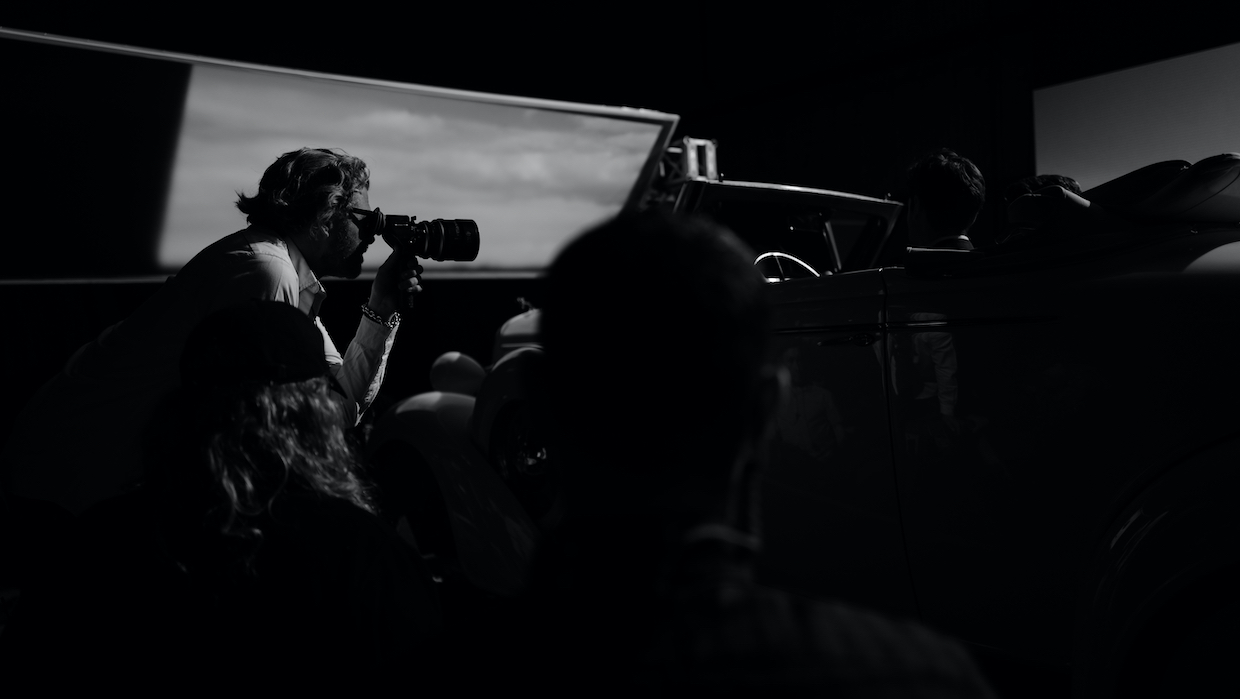 Erik Messerschmidt on the set of Mank
Erik Messerschmidt on the set of Mank In 1941, a 25-year-old Orson Welles made one of cinema’s most auspicious debuts by directing, co-writing, starring in and producing Citizen Kane. With Mank—David Fincher’s look at the evolution of Kane’s screenplay—cinematographer Erik Messerschmidt makes an impressive feature bow of his own.
After working his way up through the ranks of grip and electric and earning DP credits on the shows Legion, Mindhunter and Fargo, Messerschmidt’s very first fiction feature has landed him in the midst of Oscar conversation. With Mank now streaming on Netflix, Messerschmidt spoke with Filmmaker about deep focus, high ISOs and painting in lens flares; and how even when working with David Fincher you “start compromising when you get out of bed in the morning.”
Filmmaker: Let’s start by digging into the cameras you used for Mank. Red built you a custom variant of their monochrome sensor?
Messerschmidt: We had a Helium monochrome sensor and Red fashioned a couple of Red Ranger bodies for us with that sensor, which is a camera body that they build for rental houses that has a few more features on it that are more directed toward the rental market, like additional SDI outputs. It’s a slightly larger camera, but a little bit more production-ready than their DSMC2 build. We had three of those, then a couple DSMC2 Weapons with monochrome sensors that we used for stripped-down camera positions or in the gimbal with the Ronin.
Filmmaker: Why did you go with the monochrome camera as opposed to shooting on a regular Red and desaturating? Was it technical considerations or was their something less quantifiable about the look you preferred?
Messerschmidt: Initially I actually had a hunch that perhaps the color camera would be better for us in the DI because we could grab certain colors and grade them independent of others. We shot a series of tests and we went and screened them—the Red [color] camera against the black and white camera—and it was a mind-blowing difference within 10 seconds of the images coming up on the screen. It was very, very clear that the black and white camera rendered images that were much more like what we wanted to see. The black and white camera has tonal depth the color camera just didn’t have. Even when we tried to grade the color camera to get it where we wanted, it just didn’t compare. The monochrome camera looked like a silver gelatin print and it had this three-dimensional quality to it. It also has much more dynamic range than the color camera does. I don’t know why exactly, maybe it has to do with the debayer process [that the color camera has to perform], but it is a remarkable difference. So, we picked the black and white sensor purely empirically. We just looked at it and said, “Well, clearly we’re going to do this.”
Filmmaker: In all the behind the scenes shots I’ve seen from Mank with monitors in them, the camera is always set to 3200 ISO.
Messerschmidt: We tested it at 1600, 2000 and at 3200. We shot the film primarily in very deep focus—usually at a T8 or an 11—so I was keen to push [the ISO up to 3200] because it would lighten the load in terms of lighting. And we really liked the qualities the camera gave us at that ISO setting. It gets a little contrastier. You start to see a little bit of noise in the shadows, which we quite liked and looked a little bit like film grain. We shot 3200 for exteriors as well, because we liked the grain structure that we were getting. So, we used a lot of ND for exteriors, then I also shot with some color filtration outside as well—a Harrison Orange #2 filter and sometimes a red filter.
Filmmaker: With the early Red cameras—back in the Epic days—I remember people talking about how you needed to expose to the right on the histogram because if you underexposed you were in trouble. As Reds have evolved, do you not have to worry as much about the low end of the curve anymore?
Messerschmidt: No, I just protect the highlights. I feel like the camera has detail for days in the shadows. I do subscribe generally to the “expose to the right” approach, though. I didn’t use to, but I’ve turned around on that just because I feel like the color fidelity is superior if you put a little bit more light onto the sensor. I have that same opinion for every digital camera, not just Red.
Filmmaker: I talked to James Kniest about his work on the black and white episode of The Haunting of Bly Manor and he said the biggest difference for him was that he could use harder, punchier sources. How did you find yourself lighting differently with Mank?
Messerschmidt: I would agree with that statement—I think black and white is more accepting of hard light—but it’s also because the audience is more accepting of it. They’re so used to seeing black and white lit that way, because that lighting technique is most associated with classic cinema. Soft light has become very much in vogue. It’s fashionable now to light the entire set with three foot-candles and really work deep in the toe. It’s next to impossible to light with hard light when you’re lighting at those light levels. It’s much easier to work with hard light when you’re at 150 or 200 foot-candles.
I do think the absence of color separation, in terms of explaining depth in the frame, means that you have to rely on other techniques to explain depth and shape. Contrastier light sources and light sources with more texture are incredibly helpful for that. It’s much more difficult to explain three-dimensionality in black and white with soft ligh,t because the wrap and the smoothness of soft light has a tendency to blend, particularly the foreground and background, and especially if you’re in shallow depth of field.
Filmmaker: I’m going to read a Fincher quote for you from an interview in Vulture: “[Visually,] our notion was we’re going to shoot super-high resolution and then we’re going to degrade it. So we took most everything and softened it to an absurd extent to try to match the look of the era.” Tell me about that “degrading” process on your end of things.
Messerschmidt: David and I did a ton of testing and looked at different methodologies in terms of how to prepare the [digital] negative for the things we wanted to do. We knew where we wanted to go, we just had to figure out how to get there. One of the things we did was a DI technique that our colorist Eric Weidt came up with at David’s request, which was something we ended up calling “the black bloom.” We essentially keyed the blacks and blurred them ever so slightly, and it creates this kind of softness and duped feeling that we associated with the duplication process of release prints.
We also really enjoyed the lens flare painting we had done in Mindhunter, so we did that again with Mank. It’s kind of an exciting thing to be able to art direct flares. We normally accept flares as this happy accident. Even if you pick lenses that flare on purpose you can never predict how they will flare, so being able to be really specific about what we wanted was cool. We shot some tests and pulled some reference images of the flares we liked, sent them to post and they elaborated on those ideas.
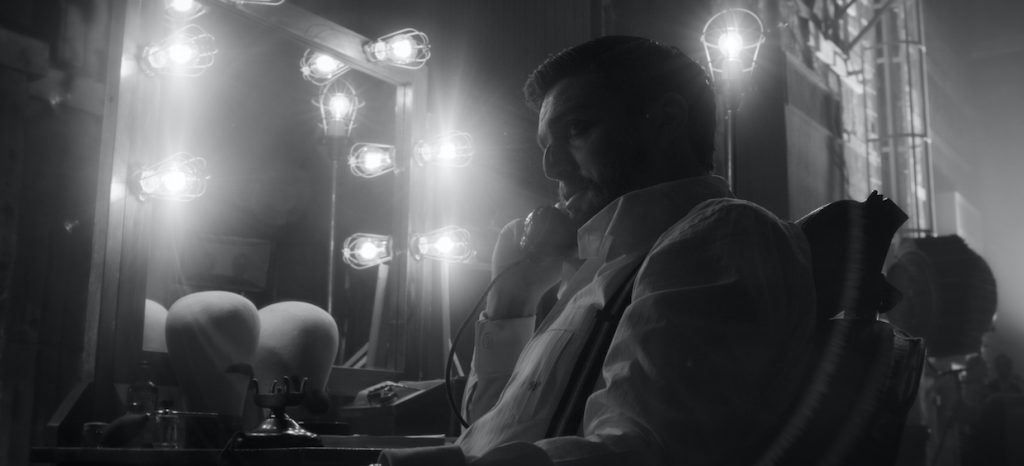
Filmmaker: So all those unique flares we see from the period practicals were created in post?
Messerschmidt: Almost all of them, yeah. Lens technology has gotten to the point where the coatings are so good on modern lenses they’re very difficult to flare. Something like the Leicas or the Master Primes, they’re almost flare-less. But we were shooting at deep stops and we needed the resolution of modern lenses. All lenses, even including modern lenses, really start to fall apart at an 11, in terms of resolution. They go from 200 line pairs of resolution down to 60 or 70. Right then and there you’re losing a tremendous amount of resolution. So if I had shot vintage lenses, they would’ve been even worse [at those deep stops]. I even tested some Cooke Panchros and they were like 40 line pairs of resolution at an 11. So the vintage lens thing wasn’t an option. We ended up back on the Leica Summilux lenses [that we used on Mindhunter].
I had seen these flares—particularly in films like [the 1955 noir] The Big Combo—that happen with the glass of that era where you get these ring flares around highlights, these very distinct halos. It’s not like spherical aberration we all go for now with diffusion on the lens or detuned lenses. It’s a very distinct ring. I thought it was kind of cool and looked like the period. I sent it to Fincher and said, “I think we should do this.” So, all those ring flares have been painted in, like the flares around the Fresnels when we’re at [William Randolph Hearst’s estate in] San Simeon and when we’re at MGM when Louis B. Mayer is talking to [the studio’s employees about taking a Depression-fueled pay cut].
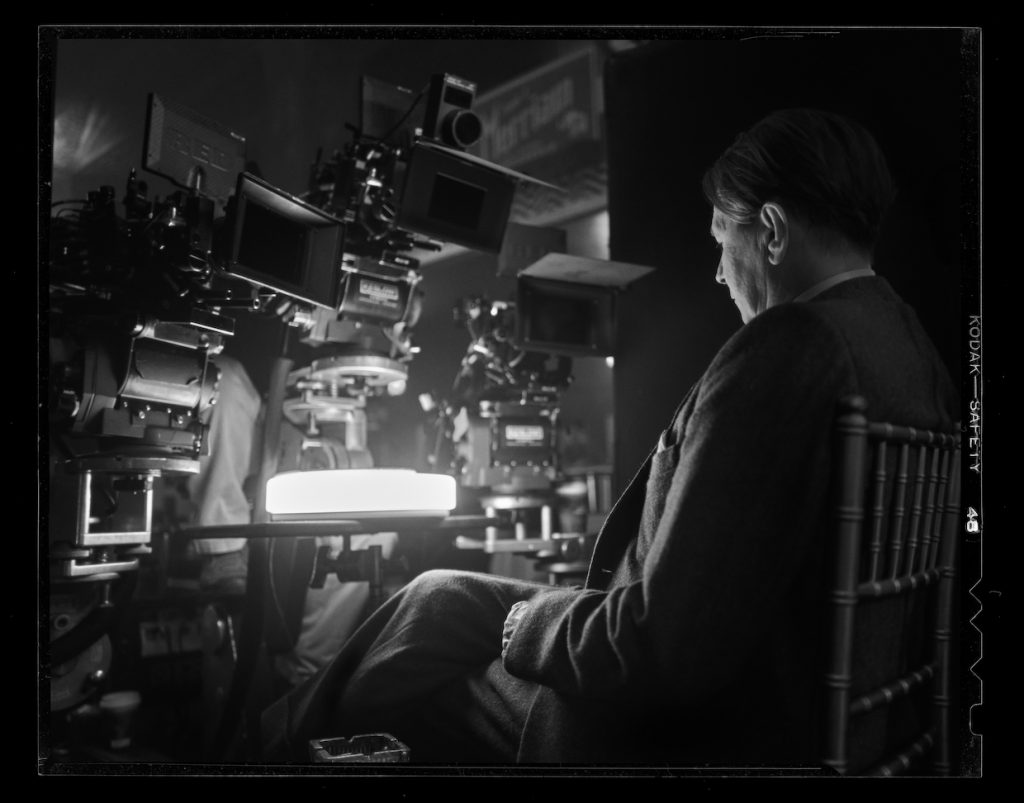
Filmmaker: Is it difficult working with multiple cameras on a Fincher project? Cinematographers often talk about the compromises that come in terms of lighting and camera position when you shoot multi-cam. Maybe it’s just his reputation for being very particular about what he wants, but Fincher doesn’t seem like he’d be the kind of filmmaker who likes compromising.
Messerschmidt: Well, we compromise all day. You start compromising when you get out of bed in the morning. (laughs) David, in many cases, wants coverage. He wants pieces to cut together, but it’s never like, “Take the B-camera and find another angle.” Everything is done with intention. All the B-camera shots and C-camera shots that we did are pieces of coverage we were planning on using and that we needed. We don’t find shots, we build them. I generally don’t light a set until we know where we are going to put all the cameras and what the coverage plan is going to be. And there are compromises. There’s no doubt that shooting exclusively with a single camera means you’re entirely focused on that one frame, but it’s slow and affects your output. It’s just one of those choices that you make.
Filmmaker: There’s a deep focus shot that I found striking during a Mayer birthday party at San Simeon. Herman Mankiewicz [Mank’s titular Citizen Kane co-writer] and his wife are seated in the foreground and Mayer—on the other side of this vast room—gives a toast. Everything in the frame is in focus. How did you achieve that deep focus?
Messerschmidt: We shot that scene at an 11, I think. It was a deep stop. We generally put the lens at hyperfocal to get the maximum depth of field in front and behind that particular focal distance. So, that’s a calculation we can easily make. I think we shot that on a 25mm. We generally stayed on the 21, the 25, the 35 and the 50. That came a little bit from wanting to stay on focal lengths that were available at the time [the movie is set].
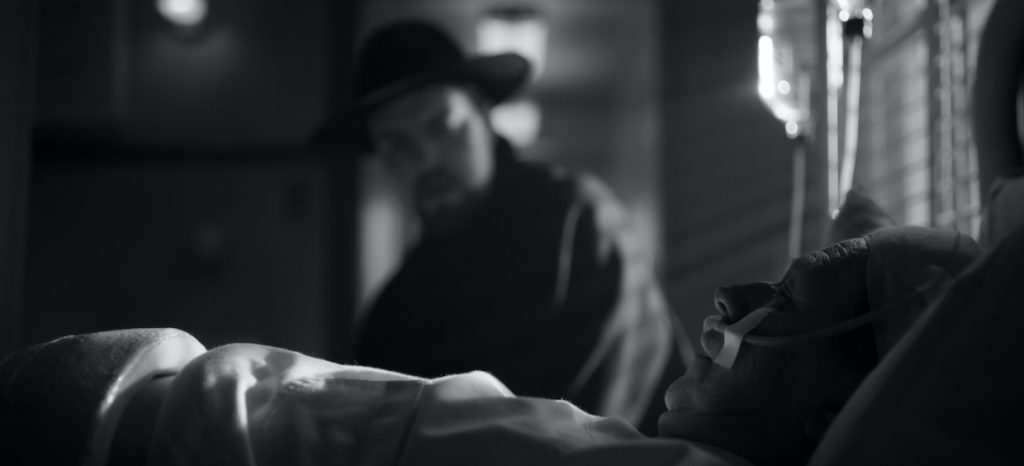
Filmmaker: Conversely, there are a few moments – most involving Welles – where you opt for shallow focus.
Messerschmidt: We debated whether or not we wanted the audience to see Welles at all until that final showdown with Mank. In the end, David decided that the audience had to see him, and Tom Burke is so good that we said, “We have to show his face.” I think the first thing we shot with him was the hospital scene where he’s walking down the hallway in that cloak. That was actually a game-time decision. I think we looked at it in deep focus and then, I don’t remember whose idea it was, but somebody said, “Should we look at it at a T2?” So I put four stops of ND in the camera and took another look at it.
We also used this tool called the cmotion Cinefade. It’s a motorized polarizer that you sync to the iris so we could effectively pull depth of field. It’s quite extreme. You could pull five stops of depth of field. So we could go from a T8 to a 2. That thing kind of lived on the camera. There were times where we’d say, “It’s too much. Let’s look at it at a 5.6.” So you set the iris to a 5.6, the polarizer compensates and now you’re looking at the same scene but with less depth of field. So, it was nice to be able to use focus and iris as a storytelling tool instead of just an exposure tool.

Filmmaker: Mindhunter was the first time I remember reading about the use of LED screens to project background plates on stage for driving shots. How has your approach to doing that evolved? Have the screens you’re using now developed to the point where they’re photo real and you don’t have to swap those backgrounds out in post anymore?
Messerschmidt: We’re at the point now where we’re at what we call “final pixel.” So yeah, we’re photo real. There are technical limitations in terms of how close you can focus to the screen, because in some instances you will get moiré, but it’s absolutely at a place where you can photograph them, and that’s what we did on this.
In terms of the driving sequences, it was very similar to how we did Mindhunter. We looked at the cars and figured out what the lens height should be, what the pan and tilt angles should be, and we would break the scenes down in terms of coverage, how many angles we needed. We’d shoot the plates at those angles, then when we put the car in front of the screens we’d match the camera to those lens heights and pan and tilt angles.
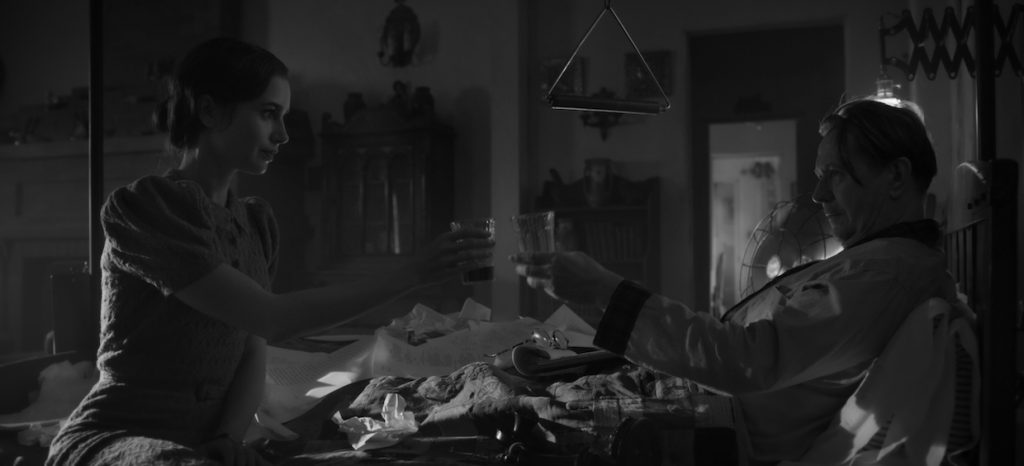
Filmmaker: Most of the scenes set in the film’s “present tense” take place at a remote ranch bungalow where Mank convalesces from a leg injury and begins work on the Kane script. How did you approach lighting that space?
Messerschmidt: The bungalow is lit primarily from the windows and with practicals. It’s soft lit. Those scenes in particular have more in common with contemporary lighting techniques than the rest of the film, and part of that was because we wanted to differentiate a little bit between modern day Mank world and flashback Mank world. So it’s lit with a lot of soft light—soft light through the curtains and the sheers and top soft boxes with LEDs and bounce light. The night scenes there are almost exclusively lit with the practicals.
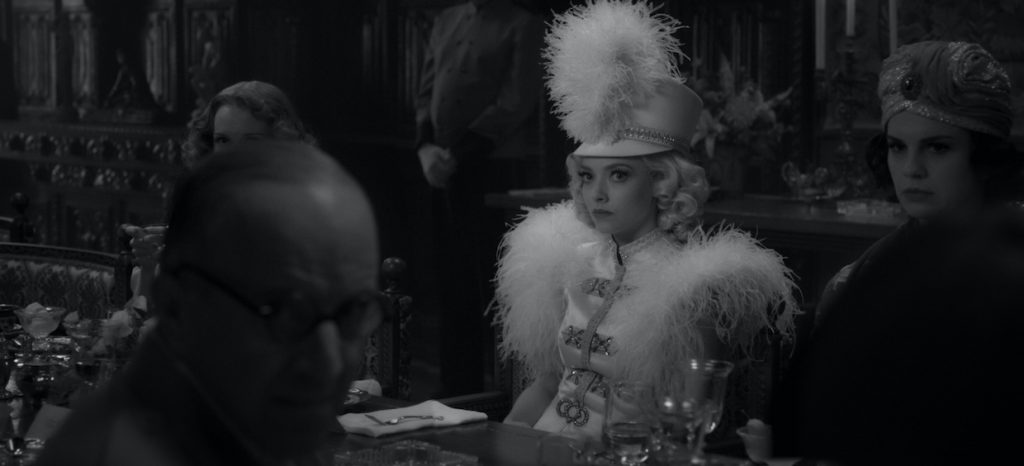
Filmmaker: Going back to San Simeon, there’s a scene toward the end of the film where a drunken Mank lays out the bones of what would become the plot for Citizen Kane in front of Hearst at a dinner party.
Messerschmidt: David had described Hearst Castle as being this cavernous space, almost crypt-like. I lit it with toplight for this sort of dull ambience. Marion Davies [played by Amanda Seyfried] is really the only person who is lit. She has this slightly softened spotlight on her the entire scene. Part of that is the idea that Mank is effectively orbiting around her. He’s walking around the room, but the subtext is he’s walking around her and I thought it would be interesting if she was this kind of beacon at the center of the orbit. There was very little relighting shot-to-shot in that scene. We’d adjust Amanda’s keylight a little bit depending on what eyeline we were in, but you could light Amanda with a car headlight and she would look great. It’s not hard to light Amanda.
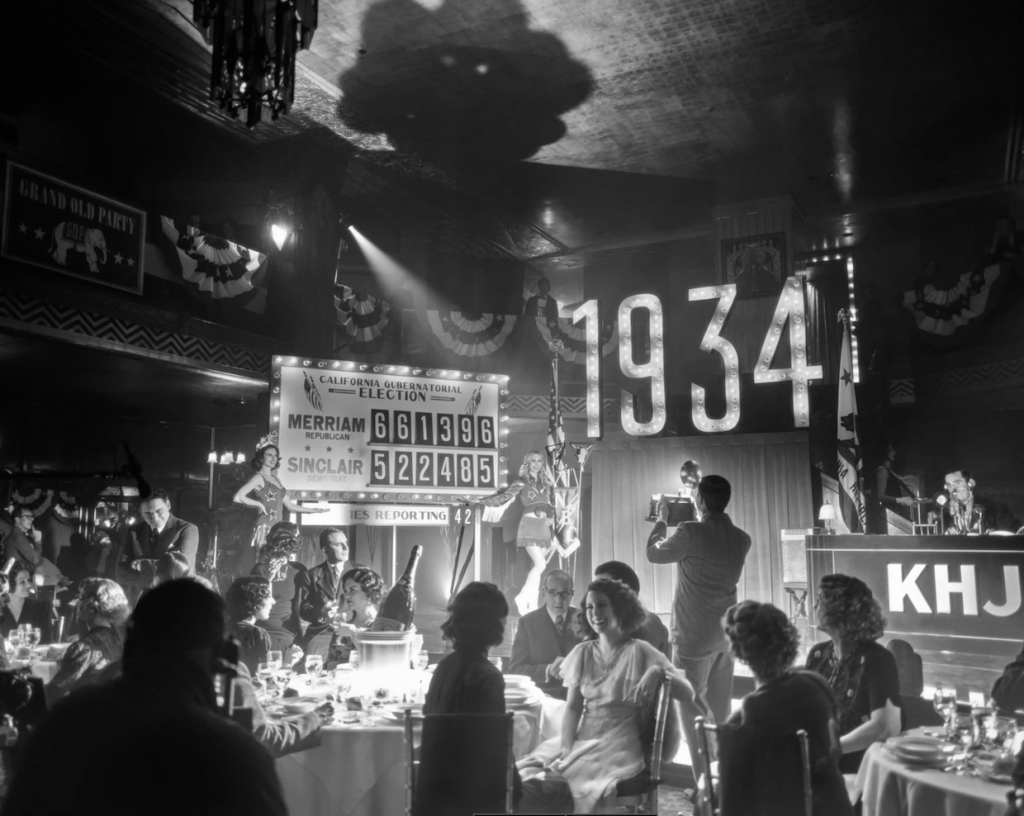
Filmmaker: A turning point for Mank is an election night party where Democratic nominee Upton Sinclair is defeated in a California governor’s race with the help of propaganda made by Louis B. Mayer.
Messerschmidt: That scene is almost exclusively lit by the practicals. [Production designer] Don Burt and I liked this idea of silhouetting the people on stage in front of something dramatic. We also built those table practicals that the champagne buckets are sitting on. That’s kind of a classic cabaret room technique—you put the light on the center of the table and everybody has key light on them. As long as we were thoughtful about where we put the camera, we would have shape. Part of that just came out of the need to be responsible in terms of lighting it for the amount of coverage we had. I was not going to have time to relight every shot considering how much coverage we needed to shoot and how long we had to shoot it. So there isn’t a lot of movie lighting going on in that scene. There’s a couple Source Fours and that’s it.
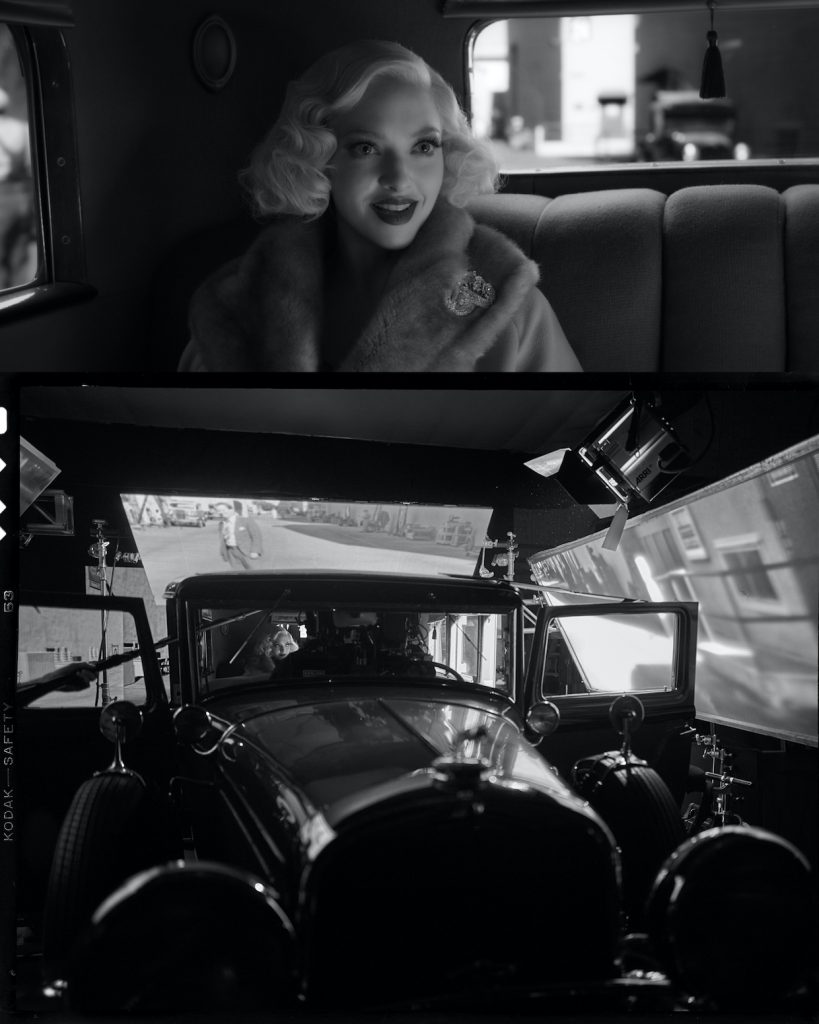
Filmmaker: You talked a little about this before, but Seyfried has this glow in Mank that I associate with leading ladies in the 1930s and 1940s—Hollywood glamour lighting.
Messerschmidt: We did some makeup tests with the makeup department—Gigi Williams and Michelle Kim were the (head) makeup artists on the movie—and looked at different bases to give Amanda a little bit of glow with slightly reflective makeup. That’s part of it. There’s no filtration on the lens at all, it’s just good makeup. And Amanda is always lit just a little bit more than everybody else. It was a place where I could lean into the 1930s glamour and it felt appropriate. We didn’t go so far as adding Mitchell Diffusion in front of the lens, but we certainly lit her a little bit more, and in scenes where everyone else is not really lit, she is.
Filmmaker: To finish up, there’s a scene where Mank—who was a compulsive gambler —is betting on the outcome of a coin flip in the writer’s room at Paramount. The coin lands on the ground spinning and goes right in front of the lens. Is that just a digital quarter or is there a story behind getting that shot?
Messerschmidt: I had gotten the Optex snorkel lens for that shot and David said, “We’ll just shoot a plate and put a CG quarter in.” But I said, “Let’s at least get a reference with a real quarter.” So, we put the Optex down and that lens sort of has to be shot at an 8 anyway—I think it’s only 5.6 wide open or something like that, but it really should be shot at an 8. So, we spun the quarter, on like the fourth take we got one that looked pretty good and David said, “Oh, maybe that one will make the movie.” It existed in the cut forever, then in the end they replaced it with a CG quarter. (laughs) It was one of those things where I thought we got away with one there for a minute.
Matt Mulcahey works as a DIT in the Midwest. He also writes about film on his blog Deep Fried Movies.
